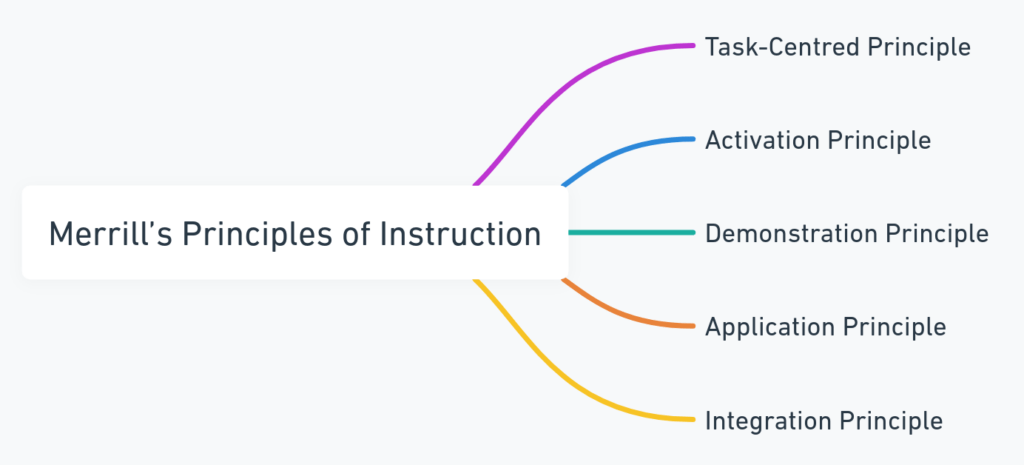In Technical and Vocational Education and Training (TVET), creating programmes that effectively equip learners with essential skills and knowledge is essential. Educational theorist David Merrill’s Principles of Instruction offers a structured approach to instructional design that suits TVET. This article explores how Merrill’s Principles can be applied to TVET programme design, detailing its core principles and practical application, its benefits and drawbacks, and how it compares with other instructional design models.
Understanding Merrill’s Principles of Instruction
David Merrill’s Principles of Instruction focuses on five core principles designed to enhance learning by making it more relevant and effective. These principles are:
- Task-Centred Principle
- Activation Principle
- Demonstration Principle
- Application Principle
- Integration Principle

1. Task-Centred Principle
The task-centred principle emphasises the importance of learning through real-world tasks. In the context of TVET, this involves designing programmes around tasks that learners are likely to encounter in their professional lives. For example, a plumbing course would involve practical tasks such as installing pipes and troubleshooting leaks. This principle ensures that learning directly applies to the workplace, enhancing its relevance and impact.
2. Activation Principle
The activation principle involves engaging learners’ prior knowledge as a foundation for new learning. This can be achieved by prompting learners to recall relevant experiences or knowledge before introducing new concepts. TVET programmes might involve discussions or reflections on past projects or jobs related to the new skills being taught. Activating prior knowledge helps learners connect what they already know and what they are about to learn, facilitating deeper understanding.
3. Demonstration Principle
The demonstration principle is about showing learners how to perform tasks or apply knowledge. This is fundamental in TVET, where practical skills are often best learned through observation. Instructors can use videos, live demonstrations, or step-by-step guides to illustrate processes. For instance, instructors might demonstrate cooking techniques in a culinary arts programme before learners try them out. Demonstrations provide a clear model for learners to follow, reducing confusion and errors.
4. Application Principle
The application principle focuses on allowing learners to practice and apply new skills in real-world contexts. This hands-on approach is a cornerstone of TVET, where learners must demonstrate competence in practical tasks. Providing opportunities for learners to apply what they have learned through projects, simulations, or internships helps solidify their skills. For example, an automotive technology programme might include lab sessions where students work on actual vehicles.
5. Integration Principle
The integration principle encourages learners to integrate new knowledge into their daily lives and professional practice. This can be facilitated through discussions, presentations, or real-world projects that require learners to use their new skills. In TVET, this might involve capstone projects or portfolios that showcase learners’ abilities. Encouraging learners to reflect on their experiences and share their knowledge with peers reinforces learning and promotes professional growth.
Benefits of Using Merrill’s Principles of Instruction
- Relevance to Real-World Tasks: Merrill’s model is highly relevant for TVET programmes as it focuses on real-world tasks, making the learning experience directly applicable to the job market.
- Engagement Through Practical Application: By emphasising demonstration and application, the model ensures that learners actively practice and refine their skills, which is essential for vocational training.
- Continuous Integration of Knowledge: The integration principle helps learners continuously apply their new skills, ensuring that knowledge is retained and used effectively.
- Structured and Clear: The principles provide a clear and structured approach to instructional design, making it easier for educators to develop comprehensive and effective programmes.
Drawbacks of Using Merrill’s Principles of Instruction
- Resource-Intensive: Implementing this model can be resource-intensive, requiring significant time and materials for demonstrations, practical applications, and real-world tasks.
- Requires Skilled Instructors: Instructors need to be highly skilled in their subject matter and in demonstrating and facilitating practical tasks, which may require additional training.
- Potential for Overemphasis on Practical Skills: While practical skills are pivotal, there is a risk of underemphasising theoretical knowledge and critical thinking skills if the model is not balanced properly.
Implementing Merrill’s Principles in TVET Programmes
1. Identify Key Tasks: Identify the key tasks that learners need to master in their chosen vocational field. Engage industry stakeholders to ensure these tasks are relevant and up-to-date.
2. Activate Prior Knowledge: Develop strategies to activate learners’ prior knowledge. This could involve pre-course assessments, introductory discussions, or reflective exercises on past experiences.
3. Design Demonstrations: Plan and create high-quality demonstrations for each key task. Use a variety of formats, such as live demonstrations, videos, and interactive guides, to accommodate different learning styles.
4. Facilitate Application: Provide ample opportunities for learners to practice new skills. Design projects, simulations, and lab sessions that allow learners to apply what they have learned in realistic settings.
5. Encourage Integration: Create opportunities for learners to integrate their new skills into their professional practice. This could involve capstone projects, internships, or presentations where learners demonstrate their abilities.
Compared with Other Instructional Design Models
While Merrill’s Principles of Instruction provide a robust framework, other instructional design models can also be valuable in designing TVET programmes. Here are a few notable examples:
ADDIE Model
The ADDIE Model is a systematic framework consisting of five phases: analysis, Design, Development, Implementation, and Evaluation. Its structured approach ensures that each phase is thoroughly addressed, making it ideal for comprehensive programme development.
Kemp Design Model
The Kemp Design Model, also known as the Morrison, Ross, and Kemp Model, features a nonlinear, circular structure emphasising continuous planning, design, and evaluation. This model’s flexibility makes it well-suited for dynamic and evolving TVET programmes.
Gagné’s Nine Events of Instruction
Robert Gagné’s model focuses on nine instructional events that support the learning process, from gaining attention to enhancing retention and transfer. This model effectively creates engaging and well-structured lessons, particularly in classroom-based TVET settings.
Bloom’s Taxonomy
Bloom’s Taxonomy categorises cognitive skills into six levels: Remembering, Understanding, Applying, Analysing, Evaluating, and Creating. This hierarchical model helps educators design learning objectives and assessments that promote higher-order thinking skills, essential for advanced TVET programmes.
Conclusion
Merrill’s Principles of Instruction provide a solid foundation for designing effective TVET programmes. By focusing on task-centred learning, activating prior knowledge, demonstrating skills, encouraging application, and facilitating integration, educators can create relevant and impactful programmes. Additionally, incorporating other instructional design models such as ADDIE, the Kemp Design Model, Gagné’s Nine Events of Instruction, and Bloom’s Taxonomy can further enhance the quality and effectiveness of TVET programmes. Continuous planning, application, and evaluation ensure that these programmes remain relevant and of high quality, ultimately contributing to developing a skilled workforce.






